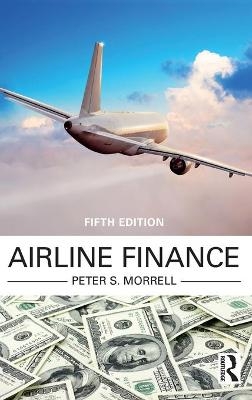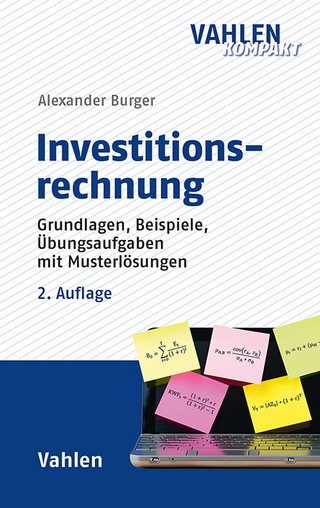
Airline Finance
Routledge (Verlag)
978-0-367-48141-4 (ISBN)
Supported at each stage by practical airline examples and recent data, Airline Finance examines the financial trends and longer term prospects for the airline industry as a whole, contrasting the developments for the major regions and airlines together with critical discussion of key issues that affect the industry as a whole. Important techniques in financial analysis are applied to the airlines as well as their investors such as banks and other financial institutions.
Thoroughly amended and updated throughout, and expanded with the addition of two new chapters, the fifth edition reflects the many developments that have affected the industry, such as the impacts of the banking and sovereign debt crises on the airline industry, signs of re-nationalisation of airlines that have emerged in Europe, and the substantial changes that have occurred in connection with rating agencies and LIBOR. New start-ups and bankruptcies are covered for the first time in a new chapter, joined by airline mergers and acquisitions (M&A), both playing a role in airline concentration. Reflecting their status as a permanent feature, fuel hedging and fuel surcharges now also have their own chapter. The medium- to long-term future in terms of further concentration and government intervention (or the lack of it) and a shift in aircraft financing towards capital markets are discussed in the final chapter.
The book is written for employees of airlines, airports and their suppliers, and investment bank and other analysts. It is also popular for use by universities and in-house courses on air transport management, within both academia and industry.
Peter S. Morrell graduated in economics from Cambridge University and subsequently gained a master's degree in air transportation from the Massachusetts Institute of Technology, where he worked on NASA-sponsored research into airline forecasting and profitability. He has a doctorate in airline capital productivity from Cranfield University. He initially worked with merchant bank Lazard Brothers, in the City, before joining the Association of European Airlines in Brussels as an economist in 1971. He worked as an air transport consultant from 1978 to 1991, when he joined Cranfield’s Department of Air Transport, retiring in 2011. He is a former head of the Department of Air Transport at Cranfield University, where he had a chair in air transport economics and finance. He is now an independent aviation advisor and a visiting professor at Cranfield University, and is on the editorial board of the Journal of Air Transport Management and Tourism Economics. He is the author of Airline Finance (the fifth edition of which will be published in 2021, and a Chinese edition in 2007), Moving Boxes by Air: The Economics of International Air Cargo, second edition with Thomas Klein (2018), and has written many papers for both academic and industry journals.
Preface; Chapter 1 Industry Financial Performance; 1.1 Government Regulation of Airlines: The ‘Level Playing Field’; 1.2 World Airline Financial Results; 1.3 Factors Affecting Financial Results; 1.4 Key Financial Issues; 1.5 Financial Implications of Environmental Measures; 1.6 Conclusions; Chapter 2 Airline Financial Statements; 2.1 Introduction; 2.2 Profit and Loss Account (Income Statement); Cathay Pacific Airways Ltd.; American Airlines; Cathay Pacific Airways and American Airlines Compared: Income Statement; Lufthansa Group and Other Airlines: Income Statement; 2.3 Balance Sheet; Assets; 2.4 Balance Sheet Comparison: Cathay Pacific Versus American Airlines; 2.5 Cash Flow Statement; 2.6 Value Added Statement; 2.7 Cash Value Added; 2.8 Progress Towards Greater Accounting Standardisation; Appendix 2.1 Frequent Flyer Programme Award Accounting; Appendix 2.2 Accounting for Finance and Operating Leases; Chapter 3 Airline Financial Ratios; 3.1 Performance/Earnings Ratios; 3.2 Risk or Solvency Ratios; 3.3 Liquidity Ratios; 3.4 Stock Market Ratios; 3.5 Inter-Airline Comparison of Financial Ratios; 3.6 Interpretation Problems; Chapter 4 Airline Valuation; 4.1 The Valuation of Intangible Assets; Route or Traffic Rights; Factors Determining the Value of Traffic Rights; Rights to Airport Slots; Valuation Methods; 4.2 The Valuation of Tangible Assets; 4.3 The Valuation of the Airline as a Whole; Discounted Cash Flow (DCF) Method; Ratio Method; 4.4 Aircraft Valuation; 4.5 Ratings Agencies; Chapter 5 Sources of Finance; 5.1 Sources of Internal Finance; 5.2 Sources of Short-Term External Finance; 5.3 Sources of Long-Term External Finance; Shareholders’ Equity Capital; Preference Share Capital; Bonds/Debentures/Unsecured Loan Stock/ABS; Equipment Trust Certificates; Term Loans; Leasing; Manufacturer’s Support; Islamic Finance; 5.4 Institutions Involved in Aircraft Finance; Banks; Export Credit Agencies; Operating Lessors; Governmental Financing Organisations; Chapter 6 Equity Finance; 6.1 Share Issues; 6.2 Equity Finance for Start-Up Airline; 6.3 Foreign Ownership Limits; 6.4 Share Trading and Stock Market Listings; 6.5 Initial Public Offering (IPO); 6.6 Mergers and Cross-Border Investment; Chapter 7 Airline Privatisation; 7.1 Introduction; 7.2 Previous Airline Privatisation Case Studies; Full Privatisation Through Flotation – British Airways; Full Privatisation Through Trade Sale and Flotation – Qantas; Gradual Privatisation – Lufthansa; Partial Privatisation – Kenya Airways; Full Privatisation and Trade Sale – Iberia; Gradual Privatisation and Acquisition – Air France; 7.3 The Results So Far by Region; North America; Caribbean; Central and South America; Europe; Africa/Middle East; Asia/Pacific; 7.4 Re-Nationalisation; Alitalia; TAP Air Portugal; Chapter 8 Airline Financial Planning and Appraisal; 8.1 Budget Preparation and Control; 8.2 Working Capital Management; Current Assets – Stocks; Current Assets – Cash and Marketable Securities; Current Liabilities; 8.3 Financial Planning; Cash Flow Forecasts; Decision Criteria; Discount Rate Calculation for NPV; Which Criterion to Choose?; Risk and Uncertainty; 8.4 Start-Up Airline Business Plan; Chapter 9 Risk Management: Foreign Currency and Interest Rates; 9.1 Exchange Rate Volatility; 9.2 Airline Trading Exposure to Currency Movements; 9.3 Airline Balance Sheet Exposure to Currency Movements; 9.4 Airline Foreign Exchange Risk Management; 9.5 Interest Rate Exposure; Chapter 10 Risk Management: Fuel Prices; 10.1 The Need and Means to Hedge Fuel; 10.2 Examples of Airline Fuel Hedging Practice; Chapter 11 Aircraft Leasing; 11.1 Finance Lease; Japanese Leveraged Leases; US Leveraged Leases; European Leveraged Leases; Extendible Operating Leases; 11.2 Operating Lease; 11.3 Japanese Operating Lease (JOL); 11.4 Wet Lease; 11.5 Sale and Leaseback; Appendix 11.1 Lease rental calculations; Appendix 11.2 Lease versus buy decision; Chapter 12 Aircraft Securitisation; 12.1 Equipment Trust Certificates: ETCs and EETCs; 12.2 Securitisation; ALPS 92-I Securitisation ; ALPS 94-I Securitisation; Airplanes 96 Securitisation; ALPS 96-I Securitisation; 12.3 Early Securitisations (2005–2008); 12.4 Conclusions; Chapter 13 Airline New Entry and bankruptcy; 13.1 Airline New Entry; 13.2 Airline Exit – Bankruptcy; 13.3 Airline Consolidation – Mergers and Acquisitions; 13.4 North America – Chapter 11 Bankruptcy; 13.5 Latin America; 13.6 UK/Europe; 13.7 Australasia; 13.8 Summary; Chapter 14 Industry Financial Prospects; 14.1 World Airline Traffic and Financial Forecasts; 14.2 World Airline Capital Expenditure Projections; 14.3 World Airline Financial Requirement Forecasts; 14.4 The Prospects for Cross-Border Mergers; Glossary of terms and abbreviations; Bibliography
| Erscheinungsdatum | 11.06.2021 |
|---|---|
| Zusatzinfo | 95 Tables, black and white; 28 Line drawings, black and white; 28 Illustrations, black and white |
| Verlagsort | London |
| Sprache | englisch |
| Maße | 156 x 234 mm |
| Gewicht | 612 g |
| Themenwelt | Technik ► Luft- / Raumfahrttechnik |
| Wirtschaft ► Betriebswirtschaft / Management ► Finanzierung | |
| ISBN-10 | 0-367-48141-3 / 0367481413 |
| ISBN-13 | 978-0-367-48141-4 / 9780367481414 |
| Zustand | Neuware |
| Haben Sie eine Frage zum Produkt? |
aus dem Bereich


